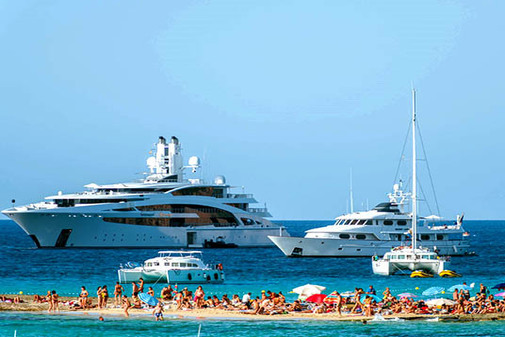From the outside they call it the Millionaire Highway, but from the inside it looks like it is the most expensive traffic jam in the world. Just 11 nautical miles, which separate Ibiza from Formentera. A landscape of blue and small islets in Indian row, as if a giant had thrown pebbles from the shore to cross on foot.
The vacations of the greatest fortunes and personalities of the world consist, most of the time, in an exodus of round trips from one island to the other. Think of the name of someone famous. Any one. A Saudi king, Prince William of England, or Messi, or Christian, or Madonna, or Oprah Winfrey, or Clinton . Whichever they want. If every time you see your selfies or photos in magazines on a yacht you wonder what they do most of the time, think of a waterway and a carbon fiber jam.
For 50 years the businessman Fernando Nieto comes from Madrid to cross it again and again. This year, in addition, the former president of the moorings of the marina of Ibiza Nueva opens a yacht: 15 meters, three decks. His modus operandi brings him learned from the capital: "You have to avoid the rush hours, between twelve and one, and between seven and eight in the afternoon."
Many say it is the largest traffic jam in the Mediterranean, but there are no official figures. Most of the vessels cannot be followed by satellite, which prevents a good photo from the tracking websites. The only thing that exists are technicians from the Ses Salines Natural Park, which in the last three years have been counted. One by one, on the four-kilometer stretch of the islets of Es Freus, which signal the shortest route between the two islands. The result is that if we placed one after another all the yachts that cross this stretch in summer, we could jump from A Coruña to New York without touching the water .
The island of Formentera has just approved restrictions on land traffic. The idea is to reduce the volume of vehicles on the roads but also the emissions. The island, 20 kilometers long and 18,000 vehicles registered, more than one per inhabitant, consumes 7,736 tons of fuel per year. However, according to the study of Environment technicians, the situation at sea is much worse. «And nobody does anything», laments the biologist Vicent Forteza.
Maritime traffic between islands represents a daily consumption of 345 tons, 20,700 tons in July and August alone, almost triple the Formentera land consumption throughout the year .
The study also says that we can see half a thousand yachts go by at rush hour, which is equivalent to one every 7.2 seconds. «To enter and leave the port you go in an Indian line, but the danger is then, at sea, because many have no idea, and go at the speed they want, and they pass you at the distance they want without nobody controls them, it's a mess, ”says Nieto.
We can see half a thousand yachts pass at rush hour, which equals one every 7.2 seconds
The island of S'Espalmador, the beach of Illetas and Cala Saona, are the favorite destinations. The yachts arrive in turns and moor as close to the shore as they are allowed, on a surface of water with the entire palette of blues: cobalt, arctic, sapphire, lapis lazuli. It is what they have come for and, paradoxically, what is most in danger of extinction. Under the hull, Posidonia, an underwater plant, works as a treatment plant. It is forbidden to anchor on it, under penalty of fine of 100 to two million euros, because the anchors tear it out of rennet, but the means to monitor it are almost nonexistent. Ibiza and Formentera lose between 1% and 5% of their meadow per year .
For Fernando Nieto, «nautical tourism is sold out». From luxury, he explains, "three live, and the rest of us have been harmed," which has led some of the friends with whom he arrived half a century ago, to leave the island.
In low season, the rental of a 20-meter yacht costs you at least 20,000 euros a week . Once the traffic jam is over, in the favorite areas of anchorage, life looks like a drive-in, or that of 13, Rue del Percebe . Conversations on the deck are made public, menus are smelled, when music is not heard. "Sometimes it's unbearable, but you can't call the local police like when a neighbor puts the music on loud, and you're not going to call the Coast Guard, because they'll tell you 'hey sir, go somewhere else'" Grandson complains.
But noise does not only affect the surface. Noise pollution caused by engines is not doing well for a population of about 60 dolphins, according to the latest study by the Tursiops Marine Research Association. Nor is the speed at which vessels circulate, which not only puts them at risk of collision, but also some cetaceans, and an increasingly large turtle population, due to the average increase in water temperature.
Another problem, Nieto explains, is to go swimming from the boat. "Before you could go a kilometer without risk, now it is impossible," he says. Australian tourist Stephen Jones visited last July Formentera to celebrate his 40th birthday with his wife. On the 11th they rented a boat, then anchored, and Jones swam. Soon he was hit by another boat. He died instantly.
According to the criteria of The Trust Project
Know more- Ibiza
Balearic Islands Rats and cockroaches invade the streets of Ibiza
Christian Clavier Interview: "Ushuaïa is like the Hollywood of nightclubs"
Italy Salvini asks to take immigrants from Open Arms to Ibiza "to have fun"

